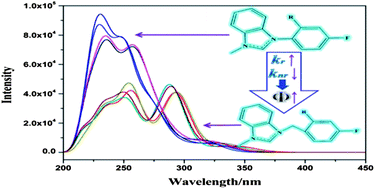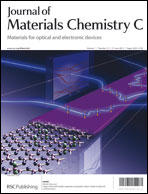A DFT/TDDFT investigation was performed on the electronic structures, basic photophysical properties and potential OLED applications of a series of Ir(III) complexes [(fpmb)2Ir(fptz)] (1a), [(dfpmb)2Ir(fptz)] (2a), [(fpmb)2Ir(bptz)] (3a), [(dfpmb)2Ir(bptz)] (4a) [where H2fpmb = 1-(4-fluorophenyl)-2,3-dihydro-3-methyl-1H-benzo[d]imidazole; H2dfpmb = 1-(2,4-fluorophenyl)-2,3-dihydro-3-methyl-1H-benzo[d]imidazole; fptzH = 2-(5-(trifluoromethyl)-2H-1,2,4-triazol-3-yl)pyridine; bptzH = 4-tert-butyl-2-(5-(trifluoromethyl)-2H-1,2,4-triazol-3-yl)pyridine] and [(fbmb)2Ir(fptz)] (1b), [(dfbmb)2Ir(fptz)] (2b), [(fbmb)2Ir(bptz)] (3b), [(dfbmb)2Ir(bptz)] (4b) [where H2fbmb = 1-(4-fluorobenzyl)-2,3-dihydro-3-methyl-1H-benzo[d]imidazole; H2dfbmb = 1-(2,4-fluorobenzyl)-2,3-dihydro-3-methyl-1H-benzo[d]imidazole] bearing two conjugated and nonconjugated carbene ligands respectively and one blue-emitting chromophore that possesses a much larger ligand energy gap. It is found that the photophysical properties of these complexes are greatly affected by the properties of the adopted ligands. From 1b to 4b, the insertion of a saturated σ-bond methylene spacer into the carbene ligand renders an increase of the HOMO–LUMO energy gap, but relatively weak absorption intensities. The emission spectra are slightly influenced by the switch between conjugated and nonconjugated ligands. Furthermore, on the basis of the calculations, the significantly higher quantum yield of 2b and 3b with respect to 3a is also explained with the assistance of their larger metal contribution to the lowest excited states (MLCT%) and smaller S1–T2 splitting energies (ΔES1–T2). Besides, the designed complexes 1b and 4b are considered to be potential candidates as blue-emitting materials with good charge transfer properties and high quantum efficiency.


 Please wait while we load your content...
Please wait while we load your content...